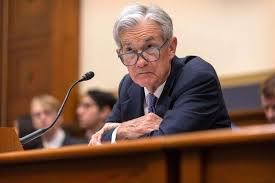Powell says Fed rate cut is on hold even as Trump demands cuts

Federal Reserve Chair Jerome Powell has made it clear: there will be no immediate rate cuts. This decision comes despite growing political pressure from former President Donald Trump.
Speaking before Congress on Monday, Powell explained that inflation, while lower than its peak, remains too high. The Fed, he said, is waiting for stronger signs of long-term stability before adjusting rates. “We are committed to making decisions based on economic data, not political pressure,” Powell told lawmakers.
Trump has publicly criticized this stance. On Truth Social, he called Powell “very dumb” and accused the Fed of damaging the economy during an election year.
A Deliberate, Data-Driven Fed
Powell reaffirmed that the Federal Reserve follows a clear mission: maintain stable prices and support full employment. Inflation remains slightly above the 2% target, and the job market continues to show strength. Because of this, Powell believes cutting rates too soon could spark another rise in prices.
“The economy is improving,” Powell said, “but not fast enough to justify a rate cut.”
Trump disagrees. He claims current rates, which sit between 4.25% and 4.50%, are hurting businesses and consumers. According to him, immediate cuts would boost demand, lift markets, and help small businesses grow.
However, Fed officials are cautious. “Cutting rates without clear signs that inflation is under control would be risky,” said one Fed member privately. “We don’t want a repeat of past inflation surges.”
A Split Inside the Fed
The debate isn’t only political. Some Fed members also support Trump’s call for rate cuts.
Trump-appointed officials like Christopher Waller and Michelle Bowman have backed the idea of a July rate cut. They point to signs of slowing job growth and weaker consumer activity.
Still, most of the Federal Open Market Committee agrees with Powell. Recent meeting notes show that the majority wants to wait until at least September. They’re watching how new tariffs from Trump on China and the EU affect inflation.
Those tariffs could drive up prices in the short term. That makes rate cuts even more complicated. “The Fed needs to decide if this inflation is temporary or more lasting,” said Laura Simmons, an economist at Brookings.
Trump’s Political Stakes
Trump’s interest in Fed policy goes beyond economics—it’s also about politics.
With the 2025 election approaching, he has used Powell’s stance as a campaign issue. Trump claims the Fed is keeping rates high to hurt his chances.
“He’s tanking the economy to help Biden,” Trump said during a recent interview. “We need rate cuts now to save jobs.”
Some analysts believe Trump is trying to shift blame. “He’s setting the stage,” said political strategist Michael Granger. “If the economy dips, he’ll say it’s Powell’s fault.”
Market Response and Next Moves
Despite the noise, financial markets remain calm. Investors expect two rate cuts this year—likely in September and December—if inflation slows and demand weakens.
The Fed’s preferred inflation measure, the PCE Index, will be released soon. Its results could influence the timing of any rate changes.
Bond markets are sending mixed signals. Short-term yields are falling, suggesting expectations for rate cuts. But long-term yields remain high, reflecting lingering inflation worries.
The upcoming jobs report, due next week, could be crucial. If job growth weakens, Powell may reconsider a cut.
A Test of Fed Independence
This moment is testing the Fed’s independence. Political figures often criticize the central bank, but Trump’s pressure is more direct than usual.
Powell has stayed firm. “We are guided by data, not politics,” he said during his testimony.
As the election nears, the Fed must continue balancing its responsibilities with outside pressure. The path ahead will demand caution, clarity, and conviction.
Conclusion
Jerome Powell’s decision to hold interest rates steady reflects the Federal Reserve’s focus on economic data over political demands. Despite Trump’s criticism, the Fed is standing by its mandate. As inflation lingers and the election approaches, this debate over rates is far from over.n.






